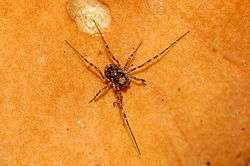Phalangiidae
The Phalangiidae are a family of harvestmen with about 380 known species. The best known is Phalangium opilio. Dicranopalpus ramosus is an invasive species in Europe.
| Phalangiidae | |
|---|---|
 | |
| Platybunus | |
| Scientific classification | |
| Kingdom: | |
| Phylum: | |
| Class: | |
| Order: | |
| Suborder: | |
| Superfamily: | |
| Family: | Phalangiidae Latreille, 1802 |
| Genera | |
|
others, see list | |
| Diversity | |
| 5 subfamilies, ca. 50 genera | |
It is not to be confused with the harvestman family Phalangodidae, which belongs to the suborder Laniatores.
Name
The name of the type genus is derived from Ancient Greek phalangion "harvestman".[1]
Systematics
- Dicranopalpinae
- Amilenus Martens, 1969 (1 species; central Europe)
- Dicranopalpus Doleschall, 1852 (12 species; Europe, South America)
- Lanthanopilio Cokendolpher & Cokendolpher, 1984 (1 species)
- Oligolophinae Banks, 1893
- Lacinius Thorell, 1876 (17 species; China, Europe, North America)
- Mitopiella Banks, 1930 (1 species; Borneo)
- Mitopus Thorell, 1876 (9 species; Eurasia, North America)
- Odiellus Roewer, 1923 (17 species; Eurasia, North Africa, North America)
- Oligolophus C. L. Koch, 1871 (4 species; Europe, China)
- Paralacinius Morin, 1934 (1 species)
- Paroligolophus Lohmander, 1945 (2 species; continental Europe and Britain)[2]
- Roeweritta Silhavý, 1965 (1 species)
- Opilioninae C.L. Koch, 1839
- Egaenus C.L. Koch, in Hahn & C.L. Koch 1839 (14 species; Eurasia)
- Himalphalangium Martens, 1973 (5 species)
- Homolophus Banks, 1893 (25 species; central Asia, North America)
- Opilio Herbst, 1798 (63 species; Eurasia, one species also in North America)
- Scleropilio Roewer, 1911 (1 species; central Asia)
- Phalangiinae Latreille, 1802
- Acanthomegabunus Tsurusaki, Tchemeris & Logunov, 2000 (1 species; Siberia)
- Bactrophalangium Silhavý, 1966 (2 species)
- Bunochelis Roewer, 1923 (2 species; Canary Islands)
- Coptophalangium Starega, 1984 (1 species)
- Cristina Loman, 1902 (13 species; Africa)
- Dacnopilio Roewer, 1911 (4 species; Africa)
- Dasylobus Simon, 1878 (19 species; southern Europe, northern Africa)
- Graecophalangium Roewer, 1923 (5 species; Greece, Macedonia)
- Guruia Loman, 1902 (5 species; Africa)
- Hindreus Kauri, 1985 (3 species; Africa)
- Leptobunus Banks, 1893 (5 species; North America)
- Liopilio Schenkel, 1951 (2 species; Alaska)
- Liropilio Gritsenko, 1979 (2 species; Russia, Kazakhstan)
- Megistobunus Hansen, 1921 (3 species)
- Metadasylobus Roewer, 1911 (8 species; Balkans, Greece, Canary Islands, France, Spain)
- Metaphalangium Roewer, 1911 (15 species; southern Europe, northern Africa, Asia Minor, Canary Islands)
- Odontobunus Roewer, 1910 (9 species; Africa)
- Parascleropilio Rambla, 1975 (1 species)
- Phalangium Linnaeus, 1758 (35 species; Africa, Eurasia, Cuba)
- Ramblinus Starega, 1984 (1 species; Madeira)
- Rhampsinitus Simon, 1879 (47 species; Africa)
- Rilaena Silhavý, 1965 (8 species; Europe)
- Tchapinius Roewer, 1929 (1 species; Kamchatka)
- Zachaeus C.L. Koch, 1839 (10 species; southeastern Europe, Asia Minor)
- Platybuninae Starega, 1976
- Buresilia Silhavý, 1965 (2 species)
- Lophopilio Hadzi, 1931 (2 species)
- Megabunus Meade, 1855 (6 species; Europe)
- Metaplatybunus Roewer, 1911 (8 species; Greece)
- Paraplatybunus Dumitrescu, 1970 (2 species)
- Platybunoides Silhavý, 1956 (1 species)
- Platybunus C.L. Koch, 1839 (22 species; Europe, Sumatra)
- Rafalskia Starega, 1963 (1 species; Asia minor)
- Stankiella Hadzi, 1973 (2 species)
Footnotes
- Tsurusaki, Nobuo (2007): Phalangiidae Latreille, 1802. In: Pinto-da-Rocha et al. 2007: 123ff
- Search results for names containing "Paroligolophus", Natural History Museum, retrieved 2013-09-15
gollark: What?
gollark: If you have a universe entirely without human values, it isn't going to be pleasantly alien and diverse or something, but just horrible and/or boring to us.
gollark: I don't see why you'd trust "the universe" to do anything but execute physics.
gollark: Solution: mirrors.
gollark: But for e.g. cancer you really just want none.
References
- Joel Hallan's Biology Catalog: Phalangiidae
- Pinto-da-Rocha, R., Machado, G. & Giribet, G. (eds.) (2007): Harvestmen - The Biology of Opiliones. Harvard University Press ISBN 0-674-02343-9
This article is issued from Wikipedia. The text is licensed under Creative Commons - Attribution - Sharealike. Additional terms may apply for the media files.